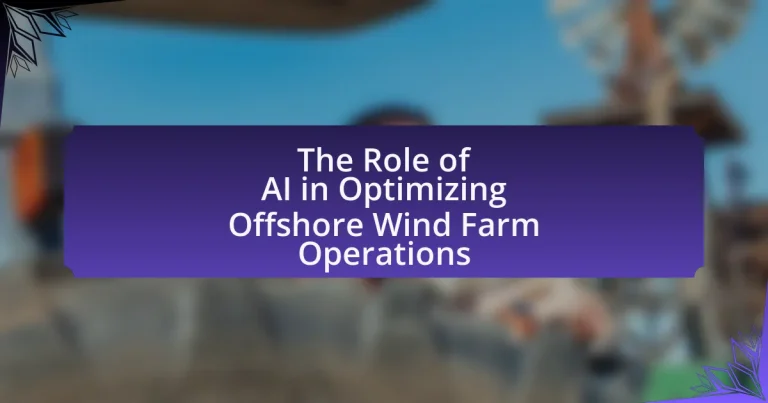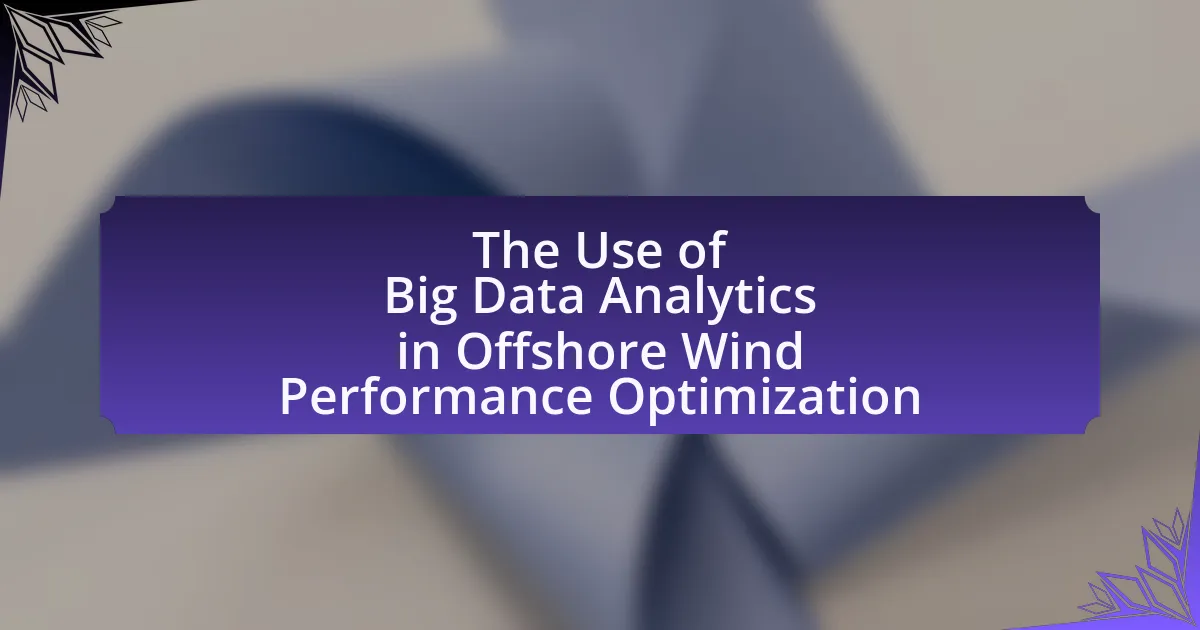The article focuses on the role of artificial intelligence (AI) in optimizing offshore wind farm operations. It highlights how AI enhances predictive maintenance, improves energy output forecasting, and streamlines operational efficiency, ultimately reducing costs and increasing energy production. Key AI technologies discussed include machine learning algorithms, predictive analytics, and computer vision systems, which collectively contribute to better decision-making and resource allocation. The article also addresses challenges in AI implementation, such as data quality and cybersecurity risks, while outlining future trends and innovations in AI applications within the renewable energy sector.
What is the Role of AI in Optimizing Offshore Wind Farm Operations?
AI plays a crucial role in optimizing offshore wind farm operations by enhancing predictive maintenance, improving energy output forecasting, and streamlining operational efficiency. Through machine learning algorithms, AI analyzes vast amounts of data from sensors on wind turbines to predict equipment failures before they occur, thereby reducing downtime and maintenance costs. Additionally, AI models can forecast wind patterns and energy production more accurately, allowing operators to optimize energy dispatch and grid integration. For instance, a study by the National Renewable Energy Laboratory found that AI-driven predictive maintenance can reduce operational costs by up to 20%. This integration of AI not only maximizes energy production but also contributes to the overall sustainability and profitability of offshore wind farms.
How does AI contribute to the efficiency of offshore wind farms?
AI enhances the efficiency of offshore wind farms by optimizing energy production and maintenance operations. Through predictive analytics, AI algorithms analyze weather patterns, turbine performance, and energy demand to forecast optimal energy generation times, thereby maximizing output. Additionally, AI-driven maintenance scheduling reduces downtime by predicting equipment failures before they occur, which is supported by studies showing that predictive maintenance can decrease operational costs by up to 30%. Furthermore, AI systems can optimize the layout and operation of wind farms, improving overall energy capture and reducing costs associated with energy transmission.
What specific AI technologies are utilized in offshore wind farm operations?
Specific AI technologies utilized in offshore wind farm operations include machine learning algorithms, predictive analytics, and computer vision systems. Machine learning algorithms analyze vast datasets from sensors to optimize turbine performance and maintenance schedules. Predictive analytics forecast energy production and equipment failures, enhancing operational efficiency. Computer vision systems monitor turbine conditions and detect anomalies in real-time, ensuring timely interventions. These technologies collectively improve the reliability and efficiency of offshore wind farm operations, contributing to increased energy output and reduced operational costs.
How does AI enhance decision-making processes in wind farm management?
AI enhances decision-making processes in wind farm management by providing data-driven insights that optimize operational efficiency and resource allocation. Through advanced algorithms and machine learning, AI analyzes vast amounts of data from various sources, including weather patterns, turbine performance, and energy demand. This analysis enables predictive maintenance, allowing operators to anticipate equipment failures and reduce downtime, which is crucial for maximizing energy production. For instance, a study by the National Renewable Energy Laboratory found that predictive maintenance can reduce maintenance costs by up to 30% and increase turbine availability by 10-20%. Additionally, AI facilitates real-time monitoring and adaptive control of wind farm operations, ensuring that energy output aligns with market demands and grid stability.
What are the key benefits of integrating AI into offshore wind farm operations?
Integrating AI into offshore wind farm operations enhances efficiency, reduces costs, and improves maintenance strategies. AI algorithms analyze vast amounts of data from wind turbines and environmental conditions, enabling predictive maintenance that minimizes downtime and extends equipment lifespan. For instance, a study by the National Renewable Energy Laboratory found that predictive maintenance can reduce operational costs by up to 30%. Additionally, AI optimizes energy production by forecasting wind patterns, which can increase energy output by 10-15%. These benefits collectively contribute to more sustainable and economically viable offshore wind energy production.
How does AI improve predictive maintenance for wind turbines?
AI improves predictive maintenance for wind turbines by utilizing advanced algorithms to analyze data from various sensors and operational parameters. This data-driven approach enables the early detection of potential failures, allowing for timely maintenance interventions. For instance, AI can process historical performance data and real-time monitoring information to identify patterns indicative of wear or malfunction, significantly reducing downtime and maintenance costs. Studies have shown that implementing AI in predictive maintenance can lead to a reduction in unplanned outages by up to 30%, thereby enhancing the overall efficiency and reliability of wind turbine operations.
What impact does AI have on energy production and cost reduction?
AI significantly enhances energy production and reduces costs in offshore wind farm operations. By utilizing predictive analytics and machine learning algorithms, AI optimizes turbine performance, forecasts energy output, and minimizes downtime through proactive maintenance. For instance, a study by the National Renewable Energy Laboratory found that AI-driven predictive maintenance can reduce operational costs by up to 20% and increase energy production by 10% through improved efficiency and reduced failure rates. This demonstrates that AI not only streamlines operations but also contributes to substantial financial savings in the energy sector.
How does AI optimize the operational performance of offshore wind farms?
AI optimizes the operational performance of offshore wind farms by enhancing predictive maintenance, improving energy forecasting, and optimizing resource allocation. Predictive maintenance utilizes machine learning algorithms to analyze data from sensors on wind turbines, allowing for the early detection of potential failures and reducing downtime. For instance, a study by the National Renewable Energy Laboratory found that predictive maintenance can decrease maintenance costs by up to 30%.
Additionally, AI improves energy forecasting by analyzing weather patterns and historical performance data, leading to more accurate predictions of energy output. This capability allows operators to better match energy supply with demand, thereby increasing efficiency. Research published in the journal Renewable Energy indicates that AI-driven forecasting can enhance energy prediction accuracy by 10-20%.
Finally, AI optimizes resource allocation by analyzing operational data to determine the most efficient deployment of maintenance crews and equipment, ensuring that resources are utilized effectively. This strategic approach can lead to significant cost savings and improved overall performance of offshore wind farms.
What role does data analytics play in AI optimization?
Data analytics is crucial in AI optimization as it enables the extraction of actionable insights from vast datasets, which enhances decision-making processes. By analyzing historical performance data, environmental conditions, and operational metrics, data analytics identifies patterns and trends that inform AI algorithms. For instance, predictive analytics can forecast equipment failures, allowing for proactive maintenance and reducing downtime. Studies show that companies utilizing data analytics in AI-driven systems can achieve up to a 20% increase in operational efficiency, demonstrating the significant impact of data-driven insights on optimizing AI performance in various applications, including offshore wind farm operations.
How is data collected and processed for AI applications in wind farms?
Data for AI applications in wind farms is collected through various sensors and monitoring systems installed on turbines and surrounding environments. These sensors gather real-time data on wind speed, direction, temperature, humidity, and turbine performance metrics such as power output and mechanical status. The collected data is then transmitted to centralized data processing systems where it undergoes cleaning, normalization, and analysis using machine learning algorithms. This processing enables predictive maintenance, performance optimization, and operational efficiency improvements. For instance, a study by the National Renewable Energy Laboratory highlights that effective data processing can enhance energy production forecasts by up to 20%, demonstrating the critical role of data in optimizing wind farm operations.
What insights can AI provide from operational data analysis?
AI can provide insights from operational data analysis by identifying patterns, predicting equipment failures, and optimizing maintenance schedules. For instance, machine learning algorithms can analyze historical performance data from wind turbines to forecast potential downtimes, enabling proactive maintenance that reduces operational costs. A study by the National Renewable Energy Laboratory found that predictive maintenance can decrease maintenance costs by up to 30% and increase turbine availability by 10-20%. Additionally, AI can enhance energy production forecasts by analyzing weather data and operational metrics, leading to improved decision-making and resource allocation in offshore wind farm operations.
How does AI facilitate real-time monitoring and control?
AI facilitates real-time monitoring and control by utilizing advanced algorithms and data analytics to process vast amounts of sensor data from offshore wind farms. These algorithms enable the continuous assessment of operational parameters, such as wind speed, turbine performance, and energy output, allowing for immediate adjustments to optimize efficiency. For instance, AI systems can predict equipment failures by analyzing historical performance data, which helps in scheduling maintenance proactively, thereby minimizing downtime. Studies have shown that implementing AI-driven monitoring systems can increase operational efficiency by up to 20%, demonstrating the significant impact of AI on enhancing the management of offshore wind farm operations.
What systems are in place for AI-driven monitoring of wind farm conditions?
AI-driven monitoring of wind farm conditions utilizes systems such as predictive maintenance algorithms, real-time data analytics platforms, and remote sensing technologies. Predictive maintenance algorithms analyze historical and real-time data to forecast equipment failures, thereby optimizing maintenance schedules and reducing downtime. Real-time data analytics platforms aggregate data from various sensors installed on turbines, enabling operators to monitor performance metrics like wind speed, turbine efficiency, and energy output continuously. Remote sensing technologies, including LiDAR and satellite imagery, provide insights into environmental conditions and help assess the impact of weather on turbine operations. These systems collectively enhance operational efficiency and reliability in wind farm management.
How does AI respond to changing environmental conditions in real-time?
AI responds to changing environmental conditions in real-time by utilizing advanced algorithms and data analytics to monitor and predict variations in weather and oceanographic factors. These systems analyze data from sensors and satellite imagery to adjust operational parameters, such as turbine orientation and energy output, ensuring optimal performance and safety. For instance, AI can predict wind speed and direction changes, allowing for proactive adjustments that maximize energy capture and minimize wear on equipment. This capability is supported by studies showing that AI-driven predictive maintenance can reduce downtime by up to 30%, enhancing overall efficiency in offshore wind farm operations.
What challenges are associated with implementing AI in offshore wind farms?
Implementing AI in offshore wind farms faces several challenges, including data quality, integration with existing systems, and regulatory compliance. Data quality is crucial, as AI algorithms require accurate and comprehensive datasets to function effectively; however, offshore environments often present difficulties in data collection due to harsh weather conditions and sensor limitations. Integration poses another challenge, as existing operational technologies may not be compatible with new AI solutions, necessitating significant investment in infrastructure upgrades. Additionally, regulatory compliance can hinder AI deployment, as operators must navigate complex legal frameworks that govern offshore energy production, which can vary by region and impact the speed of implementation.
What are the technical barriers to AI integration in wind farm operations?
The technical barriers to AI integration in wind farm operations include data quality issues, interoperability challenges, and the complexity of predictive maintenance models. Data quality issues arise from the variability and inconsistency of sensor data, which can hinder the effectiveness of AI algorithms. Interoperability challenges stem from the diverse range of systems and technologies used in wind farms, making it difficult for AI solutions to communicate and function cohesively. Additionally, the complexity of predictive maintenance models requires extensive historical data and sophisticated algorithms, which may not be readily available or easy to implement in existing operational frameworks.
How can data quality issues affect AI performance in wind farms?
Data quality issues can significantly impair AI performance in wind farms by leading to inaccurate predictions and suboptimal operational decisions. When data collected from sensors and monitoring systems is incomplete, inconsistent, or erroneous, AI algorithms struggle to learn effectively, resulting in reduced efficiency in energy production and maintenance scheduling. For instance, a study by Zhang et al. (2020) in the journal Renewable Energy demonstrated that poor data quality could lead to a 15% decrease in energy output predictions, highlighting the critical need for reliable data in optimizing wind farm operations.
What cybersecurity risks are involved with AI systems in offshore operations?
AI systems in offshore operations face several cybersecurity risks, including data breaches, adversarial attacks, and system vulnerabilities. Data breaches can occur when sensitive operational data is accessed by unauthorized entities, potentially leading to operational disruptions or intellectual property theft. Adversarial attacks involve malicious actors manipulating AI algorithms to produce incorrect outputs, which can compromise decision-making processes critical to offshore operations. Additionally, system vulnerabilities arise from outdated software or inadequate security measures, making AI systems susceptible to exploitation. According to a report by the European Union Agency for Cybersecurity, the energy sector, including offshore operations, is increasingly targeted by cyber threats, highlighting the urgent need for robust cybersecurity measures to protect AI systems.
How can these challenges be overcome?
To overcome challenges in optimizing offshore wind farm operations, implementing advanced AI algorithms for predictive maintenance is essential. These algorithms analyze data from sensors and historical performance to forecast equipment failures, thereby reducing downtime and maintenance costs. For instance, a study by the National Renewable Energy Laboratory found that predictive maintenance can decrease maintenance costs by up to 30% and improve operational efficiency. Additionally, integrating AI-driven data analytics can enhance decision-making processes, allowing for real-time adjustments to operations based on environmental conditions, which further optimizes energy production.
What best practices should be followed for successful AI implementation?
Successful AI implementation requires a clear strategy, stakeholder engagement, and continuous evaluation. Establishing a well-defined objective aligned with business goals ensures that AI initiatives address specific challenges, such as optimizing energy output in offshore wind farms. Engaging stakeholders, including engineers and data scientists, fosters collaboration and enhances the understanding of operational needs. Continuous evaluation through performance metrics and feedback loops allows for iterative improvements, ensuring that AI systems adapt to changing conditions and deliver optimal results. Research indicates that organizations with a structured approach to AI implementation see a 30% increase in project success rates compared to those without.
How can collaboration between stakeholders enhance AI integration?
Collaboration between stakeholders enhances AI integration by fostering diverse expertise and resources, which leads to more effective AI solutions. When stakeholders such as energy companies, technology providers, and regulatory bodies work together, they can share critical data, insights, and best practices that improve AI algorithms and their application in offshore wind farm operations. For instance, a study by the International Renewable Energy Agency (IRENA) highlights that collaborative efforts can reduce operational costs by up to 20% through optimized maintenance schedules driven by AI analytics. This synergy not only accelerates the development of tailored AI applications but also ensures compliance with regulations and alignment with industry standards, ultimately leading to more efficient and sustainable offshore wind energy production.
What are the future trends of AI in offshore wind farm operations?
The future trends of AI in offshore wind farm operations include enhanced predictive maintenance, improved energy forecasting, and advanced data analytics for operational efficiency. Predictive maintenance utilizes AI algorithms to analyze data from sensors on wind turbines, allowing for timely interventions that reduce downtime and maintenance costs. Improved energy forecasting leverages machine learning models to predict wind patterns and energy output more accurately, which can optimize energy dispatch and grid integration. Advanced data analytics enables operators to process vast amounts of operational data, leading to better decision-making and resource allocation. These trends are supported by the increasing adoption of IoT devices and the growing availability of big data in the renewable energy sector, which enhance the capabilities of AI systems in optimizing performance and reliability.
How is AI expected to evolve in the renewable energy sector?
AI is expected to evolve in the renewable energy sector by enhancing predictive analytics, optimizing energy management, and improving operational efficiency. As renewable energy sources like wind and solar become more prevalent, AI technologies will increasingly analyze vast datasets to forecast energy production and consumption patterns, enabling better integration into the grid. For instance, AI algorithms can process real-time data from offshore wind farms to predict maintenance needs, thereby reducing downtime and operational costs. According to a report by the International Renewable Energy Agency, AI applications in energy management could lead to a 10-20% increase in efficiency in renewable energy systems.
What innovations are on the horizon for AI applications in wind energy?
Innovations on the horizon for AI applications in wind energy include advanced predictive maintenance systems, enhanced energy forecasting algorithms, and the integration of machine learning for real-time operational optimization. Predictive maintenance systems utilize AI to analyze data from sensors on wind turbines, allowing for timely interventions that can reduce downtime and maintenance costs. Enhanced energy forecasting algorithms leverage AI to improve the accuracy of wind energy production predictions, which is crucial for grid management and energy trading. Additionally, machine learning techniques are being developed to optimize turbine performance by adjusting operational parameters based on real-time environmental data, thereby increasing overall efficiency and energy output. These innovations are supported by ongoing research and development efforts in the field, demonstrating the potential for AI to significantly enhance the operational efficiency of offshore wind farms.
What practical tips can be applied for optimizing AI use in offshore wind farms?
To optimize AI use in offshore wind farms, implement predictive maintenance algorithms to anticipate equipment failures and reduce downtime. These algorithms analyze historical data and real-time sensor inputs to identify patterns that precede malfunctions, thereby enabling timely interventions. For instance, a study by the National Renewable Energy Laboratory found that predictive maintenance can reduce maintenance costs by up to 30% and increase operational efficiency. Additionally, utilizing AI for energy forecasting can enhance grid integration by accurately predicting wind energy production, which helps in balancing supply and demand. This approach has been shown to improve forecasting accuracy by 10-20%, as reported in research by the European Wind Energy Association. Lastly, deploying AI-driven optimization tools for turbine placement and operation can maximize energy capture and minimize wake effects, leading to a more efficient overall system.




